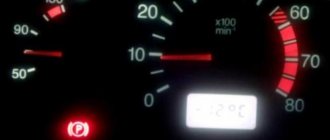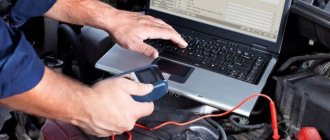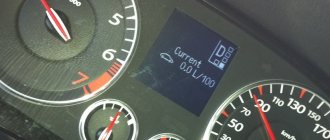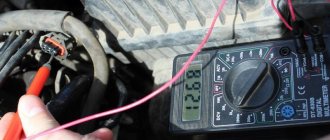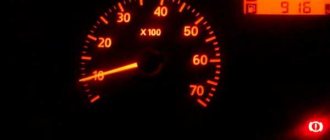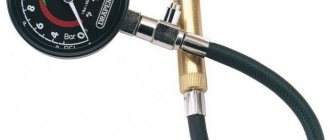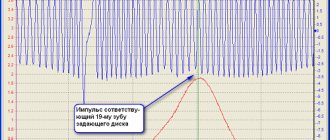BMW 525 E60 idle speed fluctuates
From the practice of our service, most often the problem of “floating” speed occurs in BMW E60 – N52 engines.
Unstable behavior of the tachometer needle at rpm from 800 to 660, especially when starting a cold engine, is noted at any mileage. There can be several reasons for the “floating” speed at idle: from a malfunction of the control device itself, or old firmware, to a clogged injector. From experience, in most cases, except for “walking idle”, the malfunction is accompanied by vibration or engine stopping. Also - a decrease in traction when the automatic transmission lever is switched to mode D, increased engine noise, changes in the color or level of engine oil, its leaks and other signs.
At a mileage of 200 thousand km, N52s are characterized by problems with Valvetronic, failure of “magnets” and wear of the Vanos control unit, which directly affect the stable operation of the engine.
The main reasons for floating speed on a diesel engine
- malfunction of the mass air flow sensor (mass air flow sensor, flow meter, MAF sensor)
- air leak (air in the fuel supply system)
- malfunctions in the EGR exhaust gas recirculation system
- corrosion / mechanical wear of fuel injection pump parts
- clogged air filter
Let's look at some of the most typical situations why the speed may fluctuate on diesel engines.
DMRV malfunction
Most often, the problem with floating speed on modern internal combustion engines is associated with the mass air flow sensor.
Previously, the mass air flow sensor was installed only on gasoline cars. On modern diesel engines, mass air flow sensor appeared recently.
It works in conjunction with the EGR valve and gives the engine ECU information about how much air is in the intake, how much exhaust gas is entering the intake depending on the opening of the EGR. And on a turbo diesel engine, the air flow sensor limits “smoke” so that fuel is supplied to the cylinders strictly based on data on how much air the engine consumed.
To check the mass air flow sensor, you need to test it with a multimeter. The normal sensor voltage is about 1V. Other sensors are checked in a similar way.
It is also necessary to pay attention to the integrity of the wires, terminals, and chips. If you suspect, replace the MAF sensor with a new one.
A faulty MAF sensor not only leads to floating speed and unstable operation of the diesel engine in transient conditions, but also to increased fuel consumption and loss of power. Various “cleaners” for sensors give only a temporary effect.
air leak
Often the reason for floating speed lies in airiness (suction of excess air) in the fuel supply system.
Air can enter the diesel fuel system from different places, it all depends on the conditions and operating life of the engine.
The main or return fuel supply lines may lose their tightness. The seals of connections, rubber fuel hoses and clamps may be damaged. It is also worth checking the connections between the fuel lines and the fuel filter. The tightness of the fuel line at the place where the fuel is drained back to the injectors is often broken.
To independently detect air leaks in the diesel fuel system, you need to check the tightness of the fuel supply system.
You need to start with a visual inspection of the engine compartment and the lower part of the car - there should be no noticeable cracks or other pipeline defects, fuel leaks or stains.
Reasons for stopping the engine at idle
Car owners and service station workers agree that the reasons for engine stalling can be:
- malfunction of the idle speed sensor, or its partial malfunction;
- malfunction of the throttle position sensor;
- presence of blockage in the throttle valve;
- clogging of the carburetor or injector (depending on the type of car).
It happens that the problem may be low quality fuel or its absence in the tank, as well as other malfunctions. If the breakdown is more serious than it seems, then it is better to contact a service station.
Carburetor is a component of the internal combustion engine power system designed to mix flammable liquid with air and supply it to the engine cylinders. The operating principle of such an engine is that the fuel, compressed in the combustion chamber, is ignited by an electric spark. Based on the number of cyclic cycles, carburetors are divided into four-stroke, two-stroke and four-stroke with a half-turn of the crankshaft.
Causes of malfunctions in a carburetor engine that cause the engine to stall:
- malfunction of the idle speed control - the engine will either stall immediately after turning the key in the ignition, or the speed will either increase or decrease (fail). The sensor rod blocks the air passage - the engine stops;
- the throttle valve is dirty - the valve does not block the air supply channel. The reason may be the formation of plaque entering through the air-fuel mixture ventilation system, the use of low-quality fuel, or a dirty air filter;
- failure of the idle speed solenoid valve, power failure - does not draw in the nozzle, which blocks the idle speed channel. The same situation is repeated in the jet itself if its holes become clogged;
- the float is jammed in the carburetor, the shut-off valve needle is blocked - the fuel supply stops, the engine stops. This problem occurs due to the accumulation of plaque, small debris in the fuel filter;
- malfunction of fuel injectors provokes interruptions or lack of idling;
- the fuel pump does not supply fuel in the required quantity to the carburetor - the engine does not receive the required amount of gasoline;
- contamination of filters (air and fuel) changes the qualitative composition of the fuel - the engine malfunctions and may stall;
- Dirty channels of the crankcase ventilation system increase the pressure of the combustible fuel-air mixture, which has an aggressive effect on the engine.
An injector is a fuel supply system, the main principle of which is to forcefully supply fuel (liquid or gas) into the cylinder. There are two types of injection - central (one injection nozzle) and distributed (many nozzles, each supplying fuel to one cylinder). To understand the reason why the injection engine stops at idle, you need to understand what functions its elements perform:
- The electronic control unit (ECU) controls the operation of the entire engine system, which receives data from the external environment, as well as about the operation of the engine. The received data is transmitted to the instrument panel;
- The pressure regulator is responsible for constant pressure in the injectors;
- supplies fuel to the injector cylinders (electromagnetic, piezoelectric, electrohydraulic);
- The fuel pump is responsible for supplying fuel to the fuel tank;
- In order for the entire system to function smoothly, several types of sensors work (knock, throttle position, voltage phases, air flow, crankshaft position).
The most common reasons for a drop in speed and engine stalling:
- The idle speed control is faulty;
- the level of pressure of the combustible mixture or air leakage is insufficient;
- the car's electronic system is faulty;
- air system flow sensors malfunction;
- spark plugs are not working.
To understand why the engine stops at idle, you need to study a little about the principle of operation of this system. A diesel engine works like this: fuel is injected into the cylinder under high pressure, while the air in the cylinder is compressed 16-25 times. High temperature causes small particles of diesel fuel to compress, causing these particles to ignite and combustion of diesel fuel.
- failure of fuel to enter the high pressure fuel pump;
- absence of a signal from the crankshaft position sensors entering the control unit.
- there is no way to regulate high pressure within specified limits (the most common reason for engine shutdown).
- depressurization of the high pressure system - the injector elements wear out and the fuel that is discharged into the return increases. It reaches volumes at which the system is unable to maintain the required pressure in the rail;
- mechanical wear of high pressure fuel engine parts;
- debris entering the internal pressure valve filter.
Stopping a classic engine running on diesel fuel occurs for the same reasons as in modern engines.
Usually, whenever the engine does not keep idle speed, the cause is contamination of parts or some kind of malfunction. The main reasons for the engine stopping may be:
- Contamination of the crankcase ventilation system.
- Malfunction of air sensor, throttle valve.
- Contamination of filters and gasoline pump.
- Clogged injector, carburetor channels, throttle valve.
- Clogged idle jet.
- Broken idle air control.
It's time to service the carburetor - minor defects
The reason for the drop in speed during warming up can also be minor breakdowns in the carburetor system. These are torn membranes, dislodged cable fastenings or a sticking damper drive. Such troubles can be cured during an inspection of this device. In the old days, every second car driver could independently rebuild the carburetor, install a repair kit and drive on, listening to the contented rumbling of the unit. Today the repair principle is as follows:
- you should go to a car store or market to find a suitable repair kit for your type of carburetor; it is better to take original high-quality parts;
- Next, it is important to find a master who is well versed in carburetors and can help with troubleshooting problems in your device; there are fewer and fewer such masters in cities;
- In a few tens of minutes, a specialist will go through the equipment, find the problem and install new gaskets, membranes, seals and other products from the repair kit;
- Next, you need to check the equipment to make sure there are no unpleasant effects; often this can only be done the next day on a cooled car;
- the last step is regular visits to the technician once every 2 years for maintenance and inspection of the carburetor, this will keep the car in normal working condition for a long period.
Tips and tricks
Let's look at how you can eliminate some of the malfunctions that lead to floating and speed jumps, and do it yourself.
- As mentioned above, the leakage of excess air can cause surges. To exclude or confirm the possibility of supplying such air, you need to check the tightness of the air supply system to the intake. You can remove the air hose and feed it air from a compressor or pump by placing the hose in a container of water. This method helps to identify cracks.
- As for the idle air control, you need to measure the resistance with a multimeter. If the resistance is between 40 and 80 ohms, this means that the device is not working.
- Also, as part of diagnostic procedures, in some cases it is necessary to clean the crankcase ventilation valve. The valve must be removed and washed with carburetor cleaning fluid or kerosene. This approach will remove deposits from the valve.
- As for the ECM sensors, in this case it is not advisable to try to repair such elements. For example, if the mass air flow sensor is faulty, it is better to immediately replace it with a new one.
- It is better to trust specialists to flush the throttle valve without proper experience, especially if such flushing is necessary with the removal of the valve. If we talk about the method of flushing the throttle without removing it, you can do the procedure yourself. The hoses are disconnected from the valve, then a cleaning aerosol is injected into the throttle.
The main thing is to disconnect the electrical contacts from the throttle valve. Let us add that on many cars where the damper was heavily dirty, you then need to additionally set the correct opening gap of the damper or “teach” the throttle using the appropriate equipment.
- On a car with a carburetor, you need to adjust the idle speed by setting it with the quality and quantity screws on the carburetor. The idle jet may also need to be cleaned. To do this, it is often enough to inject a carburetor cleaning aerosol and then blow it with compressed air.
Problems with carburetor engines
The idle system in the carburetor is the most sensitive to contamination. Therefore, if a carburetor engine stalls at idle, it is worth blowing out the jets and channels of the idle system, and on cars with electronic forced idle control, also check the operation of the economizer solenoid valve. On Solex carburetors (VAZ 2108-2109), the idle fuel nozzle is mounted on the solenoid valve rod, and if there is no voltage on the valve, it is closed. To make sure that the valve is at fault, on these carburetors it is enough to unscrew it slightly to remove the pressure of the jet against the body and allow fuel to flow past the blocked jet. Has the idle speed stabilized? This means that either the EPHH unit does not supply voltage to the valve (which is checked with a light bulb or a tester), or the valve itself is inoperative.
There are not many reasons why a valve control unit may not supply voltage to it. In addition to the malfunction of the unit itself, this is a loss of power at pin 4, a broken connection with the ignition coil (the EPHH unit stops “seeing” engine speed), and the absence of “ground” at the carburetor end (pin 5) when the gas pedal is released.
Note that a common problem with carburetors is the rigid connection between the composition of the air-fuel mixture from the vacuum and the fuel level in the float chamber. If any of these parameters change, the composition of the mixture will also “float away”. It will go beyond the limits of normal ignition - if the car does not idle until it warms up, then the mixture is over-lean, but if the car stalls when hot, then over-richness is already occurring.
A change in vacuum at idle is a consequence of air leaks through the vacuum lines (for a VAZ, this is often a vacuum brake booster or a vacuum distributor corrector) or a violation of the tightness of the joint between the carburetor and the manifold. Here, Solexes have a long-known disease with warping of the mating plane of the body; Ozones show themselves better in this regard.
The ignition on carburetor cars in the vast majority of cases is distributor-type, with the exception of two-cylinder engines, where it is enough to use a two-terminal coil without spark distribution. If the motor stalls and does not start, then the problem is hidden until the spark is emitted - look at the breaker contacts, the central high-voltage wire, the carbon contact connecting the cover and the slider.
We recommend: How to fix a gas tank breakdown yourself - repairs on the road. Cold welding gas tank repair
Problems with spark plugs are common to both carburetor and injection engines. This includes natural wear, which under normal conditions proceeds evenly; sooner or later all the spark plugs in the set will begin to work intermittently, and carbon deposits due to low-quality fuel or a violation of the mixture composition (over-enrichment, carbon black carbon deposits damage the spark plugs). Iron-containing additives (the notorious ferrocene) can “kill” spark plugs in one unsuccessful refill. So you should immediately pay attention to the candles, especially if access to them is not difficult.
RPM only fluctuates on a faulty engine
To begin with, we would like to draw the attention of readers that troubles with the engine begin precisely with the fact that the idle speed fluctuates.
If this happens to your car, then you should not put off visiting a car service center, since the consequences of floating speed can be very serious and if the fault is not detected in time, there is a high probability of ending up with serious financial expenses. There can be a lot of reasons for floating speed, ranging from breakdowns in spark plug wires, which is the least scary, to loss of compression in the cylinders, which is much worse.
Why does the carburetor become dirty?
The main enemy of the carburetor is bad fuel. It may contain a large amount of various debris that may appear in the fuel already in the car. For example, this can come from sediment at the bottom of a gasoline tank. Sediment rises when you fill up your car at a gas station.
Many cars have a fuel filter in front of the carburetor, but it needs to be changed periodically, as over time it becomes clogged and no longer cleans the fuel. The fuel pump also has a fine mesh that can become clogged and cause the engine to stall.
Aging of rubber hoses and other parts in the power system is a danger along the path of gasoline from the tank to the combustion chamber. Such parts must be changed on time, as they lose their reliability after a few years. Externally, the rubber cracks, but inside, the walls of the hoses are destroyed under the influence of chemicals contained in the fuel. Destruction products move through the channels to the engine.
The membrane of a gasoline pump often breaks down. Before it collapses, it can clog the fuel channels with pieces that have separated from it as a result of destruction.
Carburetor engines have their own reasons why the idle speed may fluctuate, both “cold” and “hot”. Let's list them:
- Incorrect carburetor setting. Most often, the cause of unstable speed, including when cold, is incorrect carburetor settings (idling).
- Dirty throttle valve or jammed travel. Along with checking the cleanliness of the throttle valve, it also makes sense to check its drive.
- The starter diaphragm is worn out. If the diaphragm partially fails (the tires may simply harden when cold), then the engine speed will be unstable. In such cases, the diaphragm is replaced with a new one.
- Carburetor gasket. If the seal is lost, excess air will enter the air-fuel mixture and until the rubber warms up, the engine speed will fluctuate. Although they may be unstable even after the engine warms up.
- Solenoid valve. If it fails, fuel consumption is disrupted.
Conclusion.
If the engine is not running stable at idle speed, during surges, or if high speeds persist for a long time, you should first carry out diagnostics for air leaks.
So, the reasons characteristic for increasing injector idle speed are as follows:
- TPDZ;
- XX regulator;
- engine temperature sensor;
- the mechanism for opening and closing the throttle valve (gas pedal cable if the gas is mechanical);
- intake air intake.
Many car owners remember the time when mainly Zhiguli and Muscovites drove along the country's roads. Their key characteristic was that it was very easy to carry out minor repairs or adjust certain parameters, only armed with a small set of tools. However, the difference between those cars and their modern counterparts was that they had a carburetor fuel supply system. She didn't use electronics, so everything was regulated mechanically.
Common problems on all engines at idle
As the old saying goes, a motor won't run if there's nothing to ignite, or nothing to ignite. For gasoline engines with quantitative control of the mode, the idle conditions are the most severe. The throttle valve is closed.
We recommend: Vacuum suction cup for removing dents
The volume of air entering the cylinder is minimal, and so is the pressure - just enough fuel mixture is supplied to allow the engine to rotate.
The oscillogram of the pressure in the cylinder, even at slightly increased speeds, gives us a pressure peak slightly above 5 bar. And this, mind you, is a serviceable engine, whose compression when hot is 13 bar. Now imagine what the pressure will be when it’s cold, when the pressure loss through the piston rings is greater. Therefore, since ancient times, almost the first thing people look at when a car stalls at idle is the condition of the engine. Measuring compression, even with a crude mechanical pressure gauge, accurately determines how worn the cylinder-piston group or valves are. In highly accelerated engines, wear is also added to by the possibility of errors when setting the marks of the gas distribution mechanism. Where the GAZ-69 works quietly when the camshaft gear is shifted by a tooth, a more modern engine is no longer able to hold idle.
Excessive pressure losses in a worn-out engine during the compression stroke can only be compensated by increasing the air supply. You have to maintain the speed with the gas pedal, but starting the engine will be a whole ritual, since at starting speed the peak compression pressure is even lower than at idle.
For a diesel engine, compression is even more important. By heating the air, which is compressed in the cylinder, the fuel injected by the injector is ignited. At the same time, the regulation of the regime in diesel engines is qualitative, not quantitative: as much air enters the cylinder as it can draw in, only the volume of injected fuel changes. But due to the fact that at idle the compression stroke time is the greatest, with loss of tightness (wear of rings, burnout of valves, losses through the cylinder head gasket), the highest loss of compression pressure will be at idle, and a diesel engine operating normally at high speeds, when released The gas pedal may also start to stall.
We must not forget about the quality of the fuel itself: it often happens that problems begin after refueling. Moreover, the emergence of network gas stations did not reduce the scale of the problems; rather, on the contrary: if previously it was possible to protect yourself from an outright “leftist” without stopping at openly suspicious gas stations (for example, in his own city, the author quickly learned where to refuel, where not, and where – only if it is urgently needed), but now gas stations of large chain companies regularly supply car repair shops with cars that stubbornly refuse to work: it is enough to mistakenly splash diesel fuel into the gas tank instead of the “ninety-two”, and even the unpretentious UAZ-469 will begin to work intermittently.

